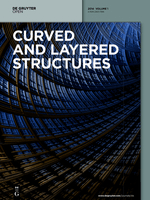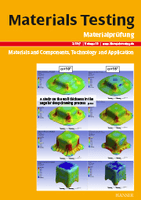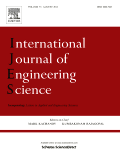
Composites-Mechanics Computations Applications
Scope & Guideline
Advancing the frontiers of composite materials and mechanics.
Introduction
Aims and Scopes
- Composite Material Mechanics:
The journal extensively covers the mechanical properties and behaviors of various composite materials, including fiber-reinforced, nanocomposite, and hybrid systems. - Computational Modeling and Simulation:
A significant focus is on advanced computational techniques such as finite element analysis, molecular dynamics, and other simulation methods to predict and analyze the performance of composite materials. - Innovative Material Development:
Research on developing new composite materials, including those with enhanced thermal, mechanical, and tribological properties, is a core area of publication. - Applications in Engineering and Technology:
The journal highlights the applications of composite materials in diverse fields such as aerospace, automotive, civil engineering, and biomedical applications. - Sustainability and Recycling:
The journal includes studies on sustainable composites and the utilization of recycled materials, addressing environmental concerns and the need for green technologies.
Trending and Emerging
- Nanocomposites and Hybrid Materials:
There is an increasing trend towards researching nanocomposites and hybrid materials, focusing on their enhanced properties and applications in various industries. - Advanced Computational Techniques:
The use of sophisticated computational methods, including machine learning and optimization algorithms, is gaining traction, enabling more accurate predictions and analysis of composite behaviors. - Focus on Sustainability:
Research addressing the sustainability of composite materials, including the use of bio-based fibers and recyclable materials, is becoming more prominent, reflecting global environmental concerns. - Multiscale Modeling Approaches:
Emerging interest in multiscale modeling techniques allows for the exploration of material behavior from the molecular to the macro scale, indicating a shift towards more comprehensive analysis. - Smart and Functional Composites:
There is a growing focus on smart composites that integrate sensors and respond to environmental changes, showcasing the intersection of material science and electronics.
Declining or Waning
- Traditional Material Reinforcement Techniques:
Research focused on conventional reinforcement methods, such as simple fiber embedding, appears to be declining as more advanced techniques and materials are being explored. - Basic Mechanical Testing Methods:
Studies that solely rely on fundamental mechanical testing without incorporating advanced modeling or simulation techniques are less frequently published, indicating a shift towards more complex analyses. - Non-Computational Approaches:
There seems to be a waning interest in purely experimental studies without substantial computational analysis or predictive modeling, as the field increasingly values integration of both methodologies.
Similar Journals

Curved and Layered Structures
Redefining Boundaries in Engineering and ArchitectureCurved and Layered Structures, published by DE GRUYTER POLAND SP Z O O, is a distinguished open-access journal that has been an essential platform since 2014 for academics and professionals in the fields of Aerospace Engineering, Architecture, Building and Construction, Civil and Structural Engineering, and Computational Mechanics. With an ISSN of 2353-7396, it is recognized for its impactful contributions, reflected in its impressive category quartiles, particularly Q1 in Architecture and notable rankings in various engineering disciplines. The journal's scope encompasses innovative research focusing on the intricate designs and applications of curved and layered structures, making it pivotal for advancing knowledge in these areas. The open-access format ensures widespread dissemination of research findings, promoting accessibility and collaboration among researchers and practitioners worldwide. As it navigates its converged years from 2014 to 2024, Curved and Layered Structures continues to attract high-quality submissions that push the boundaries of engineering and architectural design.

INTERNATIONAL MATERIALS REVIEWS
Connecting Theory and Practice in Materials EngineeringINTERNATIONAL MATERIALS REVIEWS, published by SAGE Publications Inc, is a leading journal dedicated to the comprehensive analysis of contemporary research in the fields of materials chemistry, mechanical engineering, mechanics of materials, and the study of metals and alloys. With an impressive impact factor and a Q1 ranking across multiple categories such as Materials Chemistry and Mechanical Engineering in 2023, it ranks amongst the top journals for innovative materials research. The journal has a long-standing history since its inception in 1987 and continues to serve as a crucial resource for academics and professionals alike. Although it is not open access, it is renowned for its rigorous peer-review process and its commitment to disseminating high-quality materials science research globally. Researchers, students, and industry professionals benefit greatly from the journal's insightful reviews, both for the advancement of theoretical knowledge and practical applications within the fast-evolving materials field.

Frattura ed Integrita Strutturale-Fracture and Structural Integrity
Connecting Scholars to Shape the Future of EngineeringFrattura ed Integrita Strutturale - Fracture and Structural Integrity is a prominent open-access journal published by GRUPPO ITALIANO FRATTURA since 2007, dedicated to advancing the fields of Civil and Structural Engineering, Mechanical Engineering, and Mechanics of Materials. With an E-ISSN of 1971-8993, this journal has established itself as a significant platform for researchers and practitioners in the engineering community, offering an accessible outlet for high-quality research and innovative methodologies. The journal has achieved impressive standings in the Scopus ranks, notably being positioned in the second quartile (Q2) across its relevant categories in 2023, indicating its growing influence and the quality of the research it disseminates. With a publishing scope extending from 2011 to 2024, Frattura ed Integrita Strutturale continues to be an invaluable resource for addressing the mechanics of material integrity and fracture phenomena, inviting contributions that advance understanding and foster multidisciplinary dialogue. By prioritizing open access, the journal ensures that vital research is readily available to a global audience, enhancing collaboration and knowledge sharing among academia and industry alike.

Materials Testing
Exploring the Frontiers of Materials ScienceMaterials Testing is a renowned journal published by Walter de Gruyter GmbH, serving the global scientific community in the fields of Materials Science, Mechanical Engineering, and Mechanics of Materials. With an ISSN of 0025-5300 and an E-ISSN of 2195-8572, this journal has been a significant contributor to the discourse on material performance, testing methodologies, and engineering innovations since its inception. The journal is recognized for its rigorous peer-review process and holds a commendable Q2 quartile ranking in multiple categories for 2023, showcasing its impact and relevance in the field. With open access options available, Materials Testing aims to disseminate valuable research findings and practical insights that drive advancements in technology and materials applications. By addressing the latest challenges and developments within the field, this publication serves as an essential resource for researchers, professionals, and students alike, fostering a deeper understanding of material properties and testing techniques.

COMPUTATIONAL MECHANICS
Unveiling New Horizons in Computational MechanicsCOMPUTATIONAL MECHANICS, published by SPRINGER, is a premier international journal that focuses on the intersection of applied mathematics, engineering, and computational methods. With a commendable Q1 ranking in multiple categories, including Applied Mathematics and Mechanical Engineering, this journal is pivotal for disseminating groundbreaking research and innovative methodologies that advance the field. The journal has steadily contributed to the academic community since its inception in 1986 and continues to lead discussions and practices in computational mechanics and related disciplines. With a robust impact reflected in its Scopus rankings—placing it within the top percentiles across various categories—COMPUTATIONAL MECHANICS serves as a crucial platform for researchers, professionals, and students seeking to explore and contribute to significant advancements in computational theory and mathematical applications. Although it does not currently operate under an open access model, the journal ensures wide accessibility through libraries and institutional subscriptions, fostering a rich exchange of knowledge in the global scientific community.

INTERNATIONAL JOURNAL OF ENGINEERING SCIENCE
Shaping the Future of Engineering Through Rigorous ResearchInternational Journal of Engineering Science, published by Pergamon-Elsevier Science Ltd in the United Kingdom, stands as a premier platform for pioneering research in the diverse fields of engineering and materials science. Since its inception in 1963, this journal has consistently demonstrated its commitment to advancing academic discourse, maintaining an impressive trajectory that positions it in the Q1 category across multiple engineering disciplines including Mechanical Engineering and Mechanics of Materials as of 2023. With notable Scopus rankings—placing it in the top 5% percentile for Mechanical Engineering and related fields—this journal attracts high-quality, impactful research designed for both industry practitioners and academic scholars. Although it does not currently offer Open Access options, its readership is enriched by comprehensive peer-reviewed articles, fostering a deeper understanding of complex engineering problems and innovative solutions. The International Journal of Engineering Science continues to be an invaluable resource for researchers, professionals, and students committed to pushing the boundaries of knowledge in engineering and materials science.

Functional Composites and Structures
Exploring the Synergy of Composites and Structures.Functional Composites and Structures is a prestigious academic journal published by IOP Publishing Ltd, dedicated to advancing the field of materials science with a focus on innovative composite materials and their structural applications. Established in 2019 and running through 2024, this journal uniquely bridges several disciplines, consistently ranking in the Q2 quartile across key categories including Ceramics and Composites, Electronic, Optical and Magnetic Materials, and Mechanics of Materials. With a commendable Scopus rank that places it within the top tiers of its field, the journal is instrumental for researchers, engineers, and scholars seeking to explore the latest developments in material properties, functionality, and applications. Although access options are not specified, the open-access nature of the journal promotes wider dissemination and engagement with cutting-edge research. As the demand for smarter, more efficient materials continues to grow, Functional Composites and Structures serves as a vital resource for fostering collaboration and driving innovation in material sciences.

International Journal of Mechanics and Materials in Design
Elevating Design Methodologies through Cutting-Edge ResearchInternational Journal of Mechanics and Materials in Design is a leading publication in the field of mechanical engineering and materials science, published by Springer Heidelberg. With an impressive impact factor, it holds esteemed rankings as Q1 in both Mechanical Engineering and Mechanics of Materials, and Q2 in Materials Science for the year 2023, solidifying its reputation as a significant contributor to the advancement of design methodologies. The journal focuses on the intersection of mechanics and materials, encouraging innovative research that addresses contemporary challenges faced in engineering disciplines. Researchers and professionals alike can benefit from accessing cutting-edge studies contributing to various applications, making it an invaluable resource for staying informed in this dynamic field. While the journal operates under a subscription model, its comprehensive reviews and high-quality original research foster a deeper understanding of material behavior and design principles, thus supporting the academic growth and professional development of its readers.

Frontiers in Mechanical Engineering-Switzerland
Driving Breakthroughs in Engineering ScienceFrontiers in Mechanical Engineering-Switzerland, published by FRONTIERS MEDIA SA, is a pioneering open-access journal that has been fostering innovations in the field of mechanical engineering since its inception in 2015. Based in Switzerland, this journal provides a robust platform for disseminating cutting-edge research across multiple disciplines within mechanical engineering, including materials science, industrial and manufacturing engineering, and computer science applications. With impressive Scopus rankings, including Q2 statuses in key categories such as Industrial and Manufacturing Engineering and Mechanical Engineering, it stands out as a valuable resource for researchers and practitioners aiming to stay abreast of trends and breakthroughs in these fields. By embracing open-access principles, the journal ensures that high-quality research is readily available to a global audience, thereby promoting collaboration and knowledge sharing. As it continues to grow, Frontiers in Mechanical Engineering is poised to make significant contributions to both academic and professional communities, enhancing understanding and advancing practices in engineering disciplines.

Mechanical Sciences
Transforming knowledge into practice within mechanical sciences.Mechanical Sciences is a prominent open-access journal published by COPERNICUS GESELLSCHAFT MBH since 2010, dedicated to advancing the field of mechanical engineering and its multidisciplinary applications. Operating from Göttingen, Germany, the journal has established a vital platform for researchers and professionals alike, facilitating the sharing of original research, reviews, and innovative methodologies across various domains, including civil and structural engineering, control and systems engineering, fluid flow, industrial engineering, and mechanics of materials. With a current impact factor placing it in the Q3 category across several engineering disciplines, Mechanical Sciences provides a valuable resource that not only highlights emerging trends but also contributes to the ongoing discourse within the engineering community. The journal's commitment to open access ensures that its content is widely accessible, encouraging collaboration and knowledge sharing among students, educators, and industry experts worldwide. As it continues to converge towards 2024, Mechanical Sciences remains an essential reference for anyone invested in the mechanics of engineering and related fields.